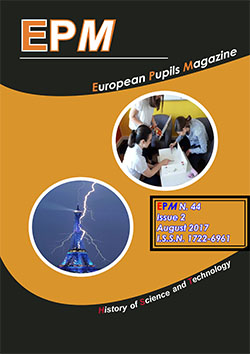Math Science Chemistry Economics Biology News Search
Introduction
What is the article about? This article is about an effort from a group of students to reproduce in the modern school environment some of the Free Fall experiments that Galileo performed.
Pisa Tower
A metal ball's free fal lfrom the Pisa Tower. Halves of the same metal ball fall free. Do they move faster, slower or the same?
The motivation
When we started, we knew about Galileo two things:
a) His attitude at the famous trial against his belief that the earth moves around the sun and
b) The picture of him performing the Free Fall experimentstower of Pisa.
Two years ago we were asked to create a website as a team, for our Technology class. We had some trouble finding a subject that would interest all three of us. Then, out of nowhere, Galileo’s life came as an idea. We all agreed for different reasons.
I believe we had fun studying Galileo, because that way we didn’t only learn his science theories, but we had the chance to think about the way he lived, trying to prove something that later turned out to be right. Because of this project, we have also come to realize how important Galileo’s theories have been for science.
We really enjoyed studying his life and we enjoyed even more a Free Fall Motion experiment that we reproduced and saw successfully.
The work
The first part of the work was to find information about Galileo’s life and his point of view. The work was focused on Galileo’s efforts to find the Free Fall motion laws.
The text is short because it is a part of a web site. In the site the portrait of Galileo and an animation of his experiments (according to the legend from the tower of Pisa) are shown.
Galileo’s point of view
Even today, after his death 500 years ago, Galileo’s theories and experiments are still taught in schools, puzzling students and teachers.
The study of Aristotle’s theory was an important issue in his life. He started trying to verify with experiments the truth in it.
According to that theory the speed of a body is the result of an action (force).
He fought for his ideas, which was really hard, because Aristotle’s theory was considered the absolute truth at that time.
Galileo and the Free Fall Experiments
Galileo performed his experiments using slopes. Why not just drop objects?
In his book The Two Sciences Galileo, suggests that:
... for a ball rolling down a ramp, the speed at various heights is the same as the speed the ball would have attained (much more quickly!) by just falling vertically from its starting point to that height. But if we make the ramp gentle enough, the motion will be slow enough to measure.
One of the main questions was: Do different bodies that Fall Free from the same height reach different velocities?
In an attempt to compare the final velocities of different bodies, Galileo let them continue their motion falling down from the bottom of the ramp. He thought to measure the horizontal distance traveled instead of the final velocity (see Picture).


